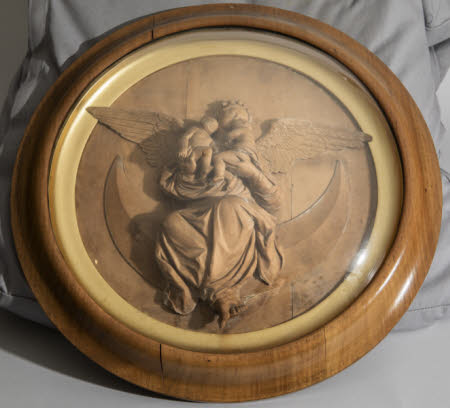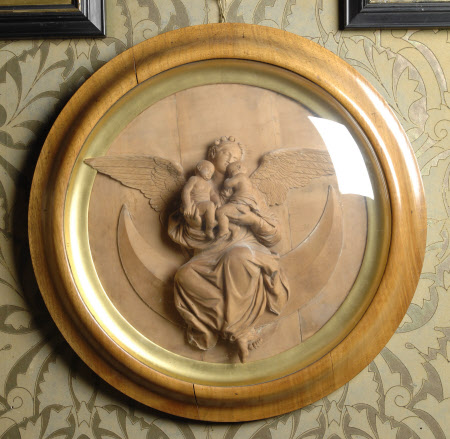Night
British School
Category
Art / Sculpture
Date
c. 1850 - 1880
Materials
Limewood
Measurements
420 mm (16 1/2 in) Diameter
Order this imageCollection
Kingston Lacy Estate, Dorset
NT 1254753
Summary
Sculpture, limewood; ‘Night’; British; c. 1850-80. A carved wooden relief depicting the ancient goddess of Night, Nyx in Greek or Nox in Latin, a winged sleeping figure holding two children personifying respectively sleep and death. Formerly attributed to the Danish sculptor Bertel Thorvaldsen (1770-1844), the relief may have been made by the British sculptor James Sherwood Westmacott (1823-1900), who exbibited a relief entitled 'Sleep' at the Royal Academy in 1851 and again in 1863.
Full description
A circular wooden relief of Nyx or Nox, the goddess of sleep, depicted as a heavily-robed young woman with wings, seated upon a large sickle moon and supporting in her arms two small children. Night is shown sleeping, whilst of the two children, one is also asleep, but the other dead. Night wears in her hair a wreath of poppy seed pods. The figure, her wings and the half-moon are all separately carved and set upon a backboard consisting of three vertical wood panels. The relief is enclosed within a wooden frame, with the inner moulding gilded and a convex glass cover. The tips of the wings of Night and her right foot extend over the edges of the moulding. On the back of the frame is a printed label for Arthur Lucas, Fine Art Publisher, with the address 37 Duke Street, from which Lucas operated between 1877 and 1881. This beautiful relief depicts the ancient goddess of the night, Nyx (Greek) or Nox (Latin). She is shown with several of her common attributes, most notably the moon signifying the night-time. The poppy seed heads woven into a wreath around Night’s head are another important attribute; poppy seeds, used to make sleeping draughts, are often found in ancient funerary images, being included to give the notion that death might just be a temporary state of sleep. The two children, one sleeping and the other dead, reflect the close relationship between the two states of being. The relief has hitherto been believed to be derived from a sculpture of this subject by the Danish neo-classical sculptor Bertel Thorvaldsen (1770-1844), among whose most popular works were a pair of circular reliefs depicting Night and Day. Several examples were made in his workshop in Rome by Thorvaldsen himself or members of his workshop, but the two designs were also widely reproduced, examples in National Trust collections including a pair in terracotta at Killerton (NT 922471). Thorvaldsen’s image of Night, with Night flying through the sky to her left, accompanied by an owl, another of her attributes, is however completely different to the Kingston Lacy relief. Thorvaldsen made no other sculptures of Night, nor are there any drawings by him suggesting he experimented with another composition of the subject, so the attribution must be considered incorrect. The relief is in what is almost certainly its original frame, which bears on the reverse a label indicating that it was bought from the fine art publisher Arthur Lucas (1842 - ?), who was active in London as a photographer and publisher of prints from 1867 until 1905, when he retired and a sale of his stock of prints was held. Lucas, who moved around a good deal in his career, is known to have operated from the premises on the label, 37 Duke Street in St James, only between 1877 and 1881. Given that Lucas appears to have dealt only in contemporary works of art, the sculpture is likely therefore also to date from around this period. It is the only sculpture currently known to have been handled by Arthur Lucas. The maker of this unsigned work was probably British, but could also have been from elsewhere in Europe, perhaps Germany. One possible candidate however might be James Sherwood Westmacott (1823-1900), one of the dynasty of Westmacott sculptors working in the nineteenth century. One of his best-known works is the oval portrait relief of his daughter Constance in the Victoria & Albert Museum, London (Inv. A.12-1968), made in around 1872. Westmacott exhibited at the Royal Academy in 1851 (no. 1286) and again in 1863 (no. 1046) a marble relief entitled ‘Sleep’. No illustration of this work is known to survive, but it seems to have been close to Thorvaldsen’s relief of Night since, in its report on sculpture in the Royal Academy summer exhibition in 1851, the Art Journal (1851, p. 162) noted that Westmacott had exhibited ‘a bas-relief, reminding us of Thorvaldsen in its composition.’ In the 1863 Royal Academy exhibition catalogue, the sculpture was accompanied by a quote from Shakespeare, ‘Downy sleep, Death’s counterfeit’. The medallion seems to have been one of Westmacott’s preferred forms in the 1850s and 1860s. In 1861 he exhibited at the Royal Academy in 1861 (nos. 1108-11) a set of medallions depicting the four winds, examples in plaster of three of which survive in the Laing Art Gallery, Newcastle-upon-Tyne. They show distinct parallels with the Kingston Lacy relief, in the full and rather voluptuous female figures and the handling of the wings. There is however no record of James Sherwood Westmacott working in wood. Jeremy Warren January 2024
Provenance
By descent to Ralph Bankes (1902-1981); bequeathed in 1981.
Marks and inscriptions
Printed Label on reverse:: FROM /ARTHUR LUCAS, / FINE ART PUBLISHER, / 37, DUKE STREET, PICCADILLY, / LONDON, S.W.
Makers and roles
British School , sculptor after Bertel Thorvaldsen (Gronnegade 1770 – Copenhagen 1844), sculptor
References
Roscoe 2009: I. Roscoe, E. Hardy and M. G. Sullivan, A Biographical Dictionary of Sculptors in Britain 1660-1851, New Haven and Yale 2009, 0. 1353, no. 63.

